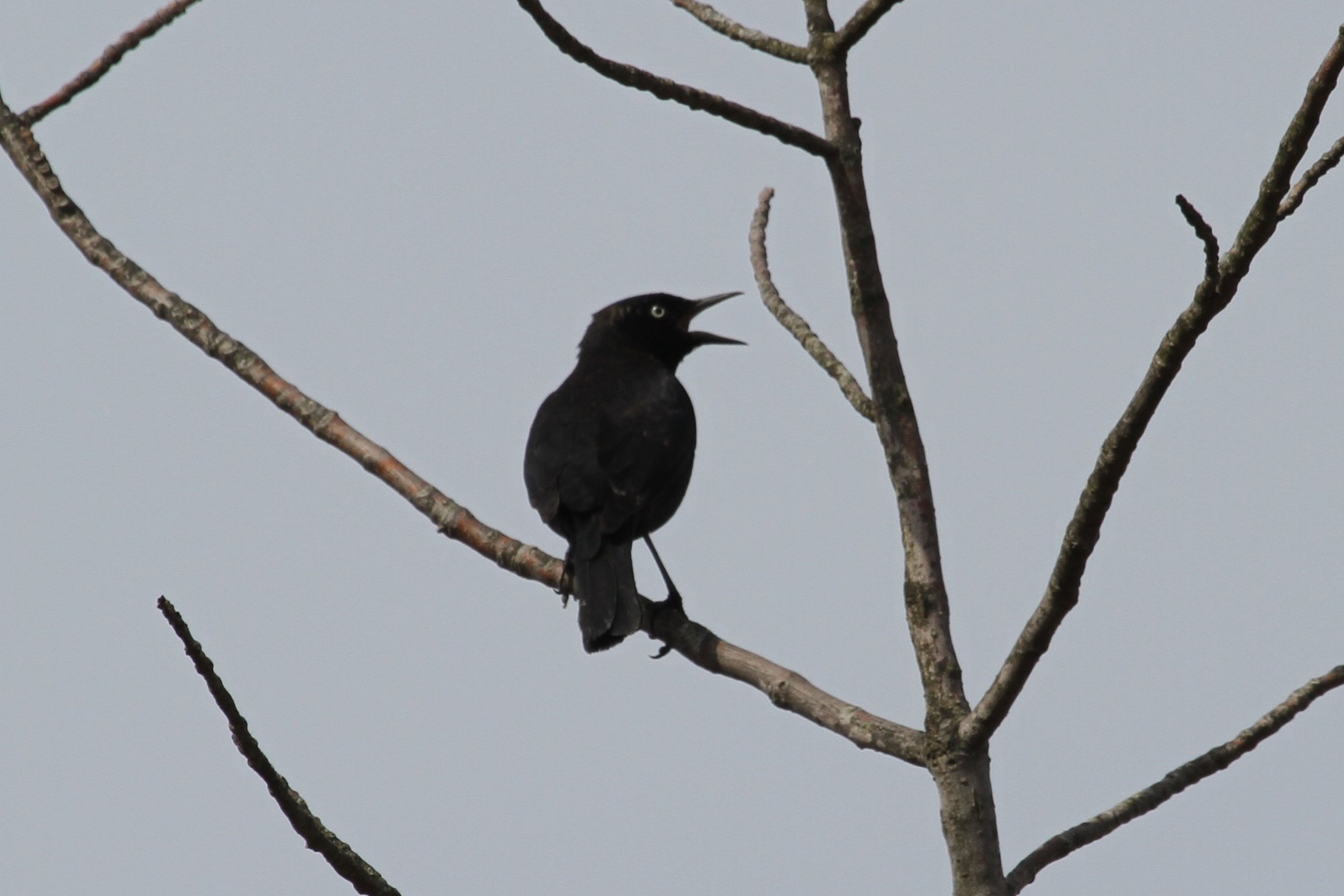Shorebirds!
Of all the fruits: cherries. Of all the months: October. Of all of the holidays: Thanksgiving. Of all of the birds: Rusty Blackbird. But--of all the groups of birds: shorebirds.
All birders have his or her favorite group or family of birds: the raptors in migration or the sparrows in a field. For many it’s easy: warblers in spring. For me, it’s shorebirds. Perhaps because I do associate them with water, the shore. Perhaps because I have spent so little time with them, the birds here in the Hudson Valley uncommon except in migration and even then there are few. Perhaps this group of birds retains a certain mystery because they are so elusive to me. And so when my friend Peter started reporting big numbers of shorebirds—a dozen Pectoral Sandpipers, a White-rumped Sandpiper, plus over forty Snipe at the Vly, a swamp in the northern edge of Ulster County, I had to go.
Of all the fruits: cherries. Of all the months: October. Of all of the holidays: Thanksgiving. Of all of the birds: Rusty Blackbird. But--of all the groups of birds: shorebirds.
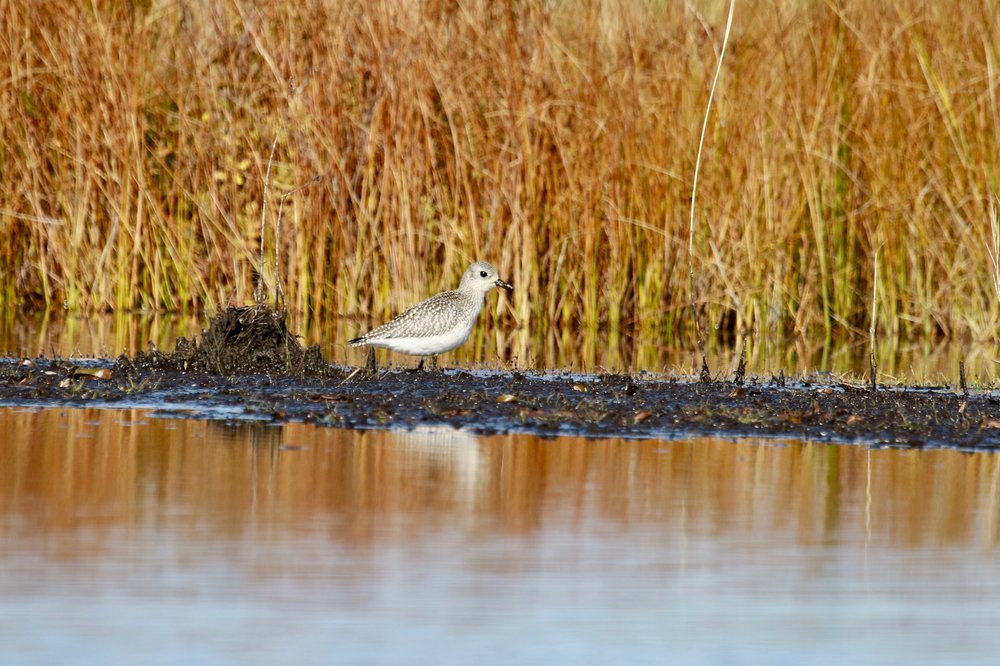
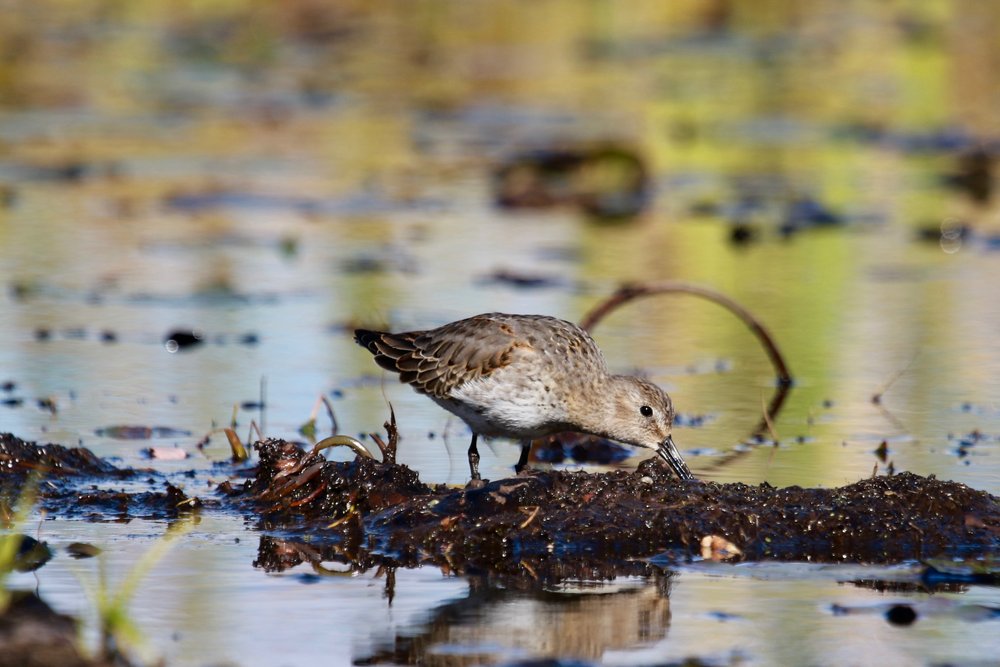
All birders have his or her favorite group or family of birds: the raptors in migration or the sparrows in a field. For many it’s easy: warblers in spring. For me, it’s shorebirds. Perhaps because I do associate them with water, the shore. Perhaps because I have spent so little time with them, the birds here in the Hudson Valley uncommon except in migration and even then there are few. Perhaps this group of birds retains a certain mystery because they are so elusive to me. And so when my friend Peter started reporting big numbers of shorebirds—a dozen Pectoral Sandpipers, a White-rumped Sandpiper, plus over forty Snipe at the Vly, a swamp in the northern edge of Ulster County, I had to go.
The wind funnels through the Vly like a natural wind tube, making paddling a challenging event. For the past few days white caps flecked the Hudson River and trees knocked back and forth, leaves in gold and red splashing to the ground. Peter explained that the Vly would be even rougher. Still: I wanted to go. Early in the day Peter texted “If you went out today we’d have to put you in an institution.” I laughed and hoped the wind would settle. It didn’t. The idea of paddling into that wind alone I could face, but I knew that the wind would make identifying the shorebirds that much more difficult, if not impossible. I didn’t want to attempt that alone. “Ok, let’s go, but be prepared,” Peter conceded.
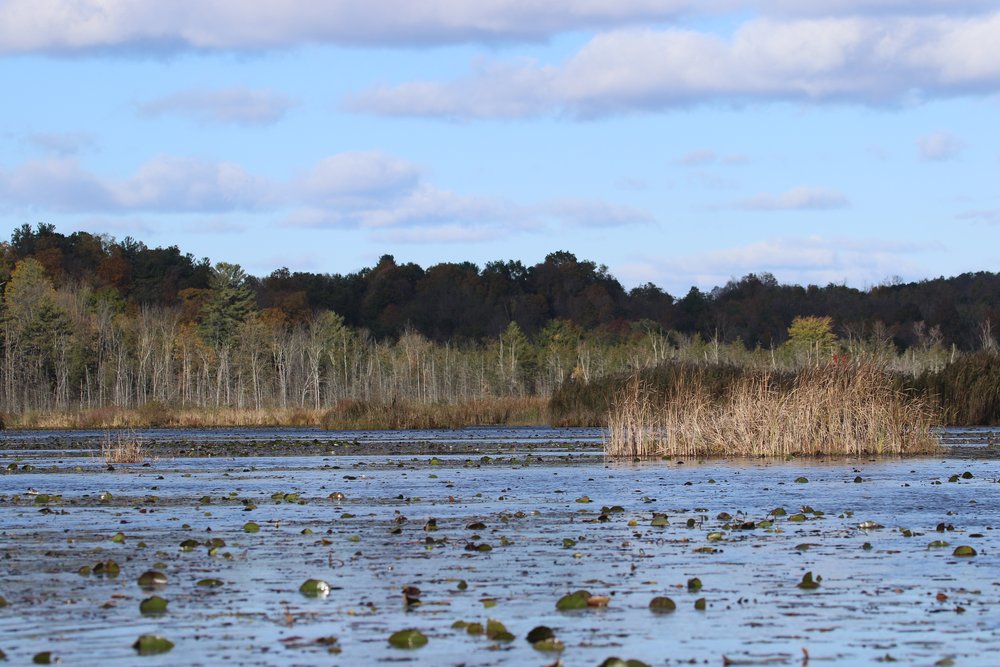
Usually in fall the place you find Peter is in a field, searching for sparrows migrating south. His persistence pays off: every year he finds good sparrows. But this year he decided to focus as well on the Vly, a forgotten bit of swamp and woods where he and his wife recently bought a piece of land. Early in the season he saw good shorebirds, at first the usual then some amazing finds like a Stilt and a Bairds. After a lull a rush of birds once again. The birding community buzzed with excitement over his finds.
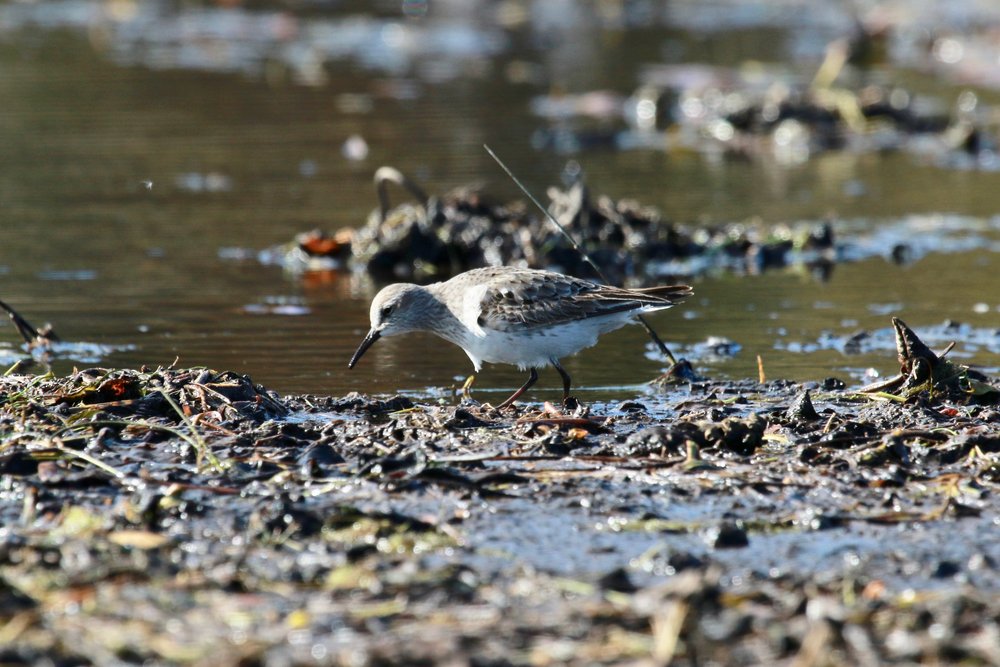
As I slid my kayak into the shallow muddy water, Peter pointed to the far shore where it looked like the land itself was moving. Birds! This is one of the great delights of shorebirds, the way they animate a seemingly empty landscape. The place was alive with birds, four Pectoral Sandpipers, a Dunlin and a Lesser Yellowlegs pulled worms and danced through the muddy flats. “If you take a few strokes, you’ll coast up on the flats and can get close,” Peter said. This too is one of the joys of shorebirds: they are often less skittish than other birds, so intent on a meal they trot in front of you, careless of danger.White-rumped Sandpiper
The sun rained down and white clouds scudded across the sky along with Crows on a mission. We pushed out of the sheltered cove where we had launched and through a patch of phragmites. On the other side: the wind tunnel. The wind plowed in broadside, knocking me in the face, freezing my hands that gripped too tight around the paddles I feared might sail off.
We both hunkered down, shoving out into the water, past muddy flats that emerged to ground my slim boat. I looked up to scan for birds from time to time, squinting into the sun that reflected off of the water, the water lilies turning brown. And thought: there’s no placed I’d rather be then there, pummeled by wind looking for shorebirds. “What we won’t do for love,” Peter called into the wind and I laughed: indeed.
Peter stopped paddling, his kayak skidding south with the wind as he put his binoculars to his eyes. “There!” Peter called, his face lit up, “A Black-bellied Plover!” A new bird in his long list of shorebirds found at the Vly. A bird never recorded before in this odd, special spot.
I found it hard to breath, whether from the wind or the excitement of the birds I couldn’t say. I tucked my paddle between belly and knee and wobbled my binoculars to my eyes. Sure enough, there was the plover, long necked with that petit black bill dancing around with his shorebird cohorts. The bird, unlike us, seemed unperturbed by the wind as it went about his plover business of finding food. Had this bird or other plovers ever before visited this lonely swamp on migration? Or was it that no one had before had been silly enough to venture out and lucky enough to see it?
This is what intrigues me about birding: for all we know about birds, and migration, for all the eyes and ears out in the field recording what we see, there is infinitely more that we don’t know. That is a good enough reason to go out and get knocked around by the wind.
“We’ll never know,” Peter said in answer to my questions.
But what I’m sure of is that every fall from here on out Peter will be combing first the fields for Sparrows, then the Vly for Shorebirds. And I will continue on my quest to get to know this group of sturdy un-shy birds with long legs that pepper mud flats and shorelines carrying out their secretive, magical lives.
Ovenbird: A singer everyone has heard
There is a singer everyone has heard,
Loud, a mid-summer and a mid-wood bird,
Who makes the solid tree trunks sound again
--Robert Frost
Even if you do not know the Ovenbird, you know the distinct, emphatic song of this little warbler: Tea-Cherr, Tea-Cherr, Tea-Cherr. Teacher teacher teacher is the mnemonic, so I think of it as my bird.

There is a singer everyone has heard,
Loud, a mid-summer and a mid-wood bird,
Who makes the solid tree trunks sound again
--Robert Frost
Even if you do not know the Ovenbird, you know the distinct, emphatic song of this little warbler: Tea-Cherr, Tea-Cherr, Tea-Cherr. Teacher teacher teacher is the mnemonic, so I think of it as my bird.
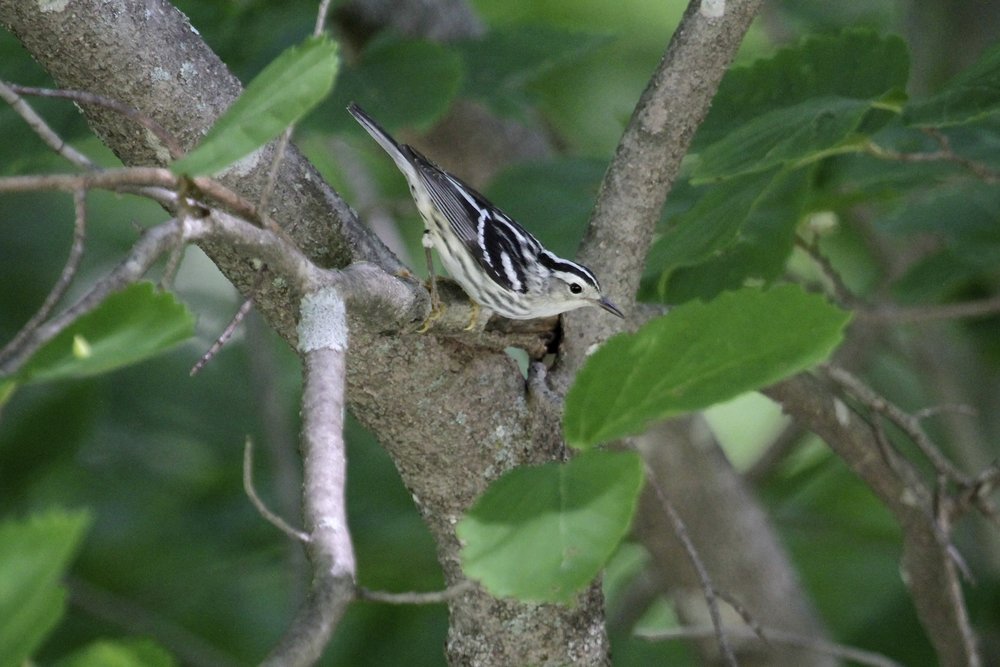
It’s the sound I listen for in spring, one of the early warblers, and in those leaf-less days, I have a chance to see the little bird with its brown speckled breast and white eye ring that makes it look in a perpetual state of alarm. Once the leaves come in, I give up hope of a look, satisfying myself with the un-warbler-like song that echoes, flat-footed through dense forests.
So this morning it came as a complete surprise when on a dirt road in a deep woods an Ovenbird came to greet me. I had been walking the sunlight dappled road, listening to the lazy teeyay, tayo of the Blue-headed Vireo, the gravelly song of the Black-throated Blue Warbler, the zee zee zee zo zee of the Black-throated Green Warbler and the music of the Black and White Warbler, which always makes me think that someone is playing one high note on a very tiny violin. Amidst this morning symphony, the Ovenbird appeared, buoyant and unafraid, not more than ten feet from the road. It was not singing. It was dancing. Its white eye-ring made it look, not startled, but wide-eyed, full of curiosity. Its white throat was outlined in brown, like a long mustache that then ran into a brown streaked breast. The streaks were twigs, the bird blending in to the woods. It hopped from a low tree limb, to a bush, across a moss-covered stump. There it stopped, cocked its tail wren-like, and asked: Do I look like a diminished thing?

Frost ends his poem on this note (full poem below) and as poets are wont to do, he makes this tilt to the end, toward our lives in decline, our lives turned to dust. It is easy to be pessimistic if we read the bird forecasts—diminishment is the story. Populations are down for songbirds in particular. But not, I am happy to say, for the Ovenbird, where over the past years in un-fragmented forests, like the one I was walking through, populations are up.
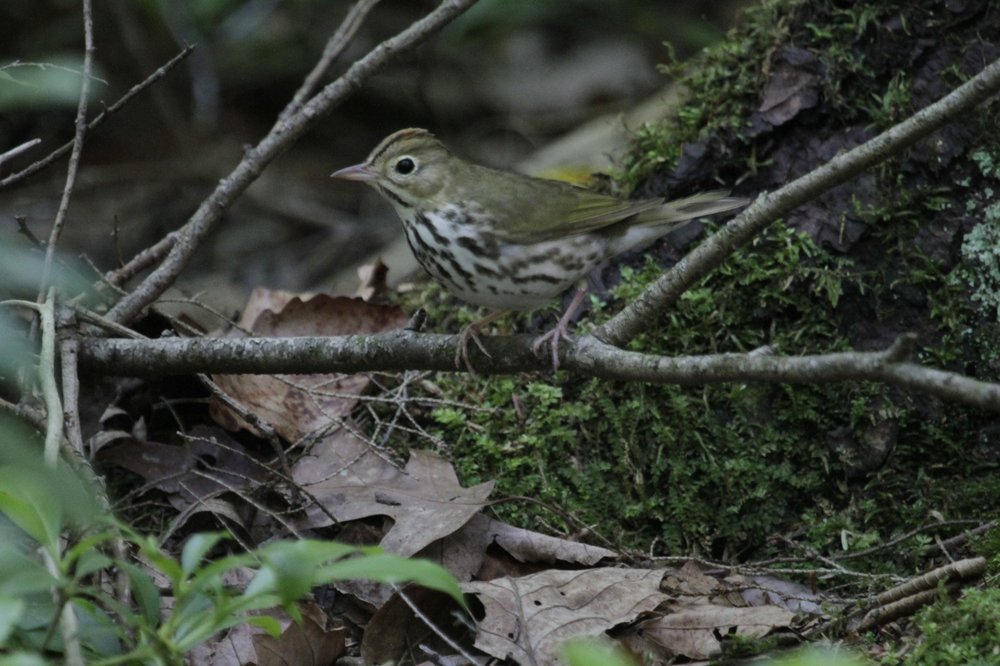
There was no dust in these woods, only the rich, dark soil of white pines and hardwoods, layers of time and rot blanketed with too-green moss. And it was to the ground that the little bird hopped. There it negotiated the territory between ferns and leaf litter, nearly vanishing in its miniature obstacle course. It then popped out not more than five feet from me—too close for me to get a photograph! —splayed its wire-thin legs, tilted its head to show the dapper mustard-brown racing cap that graces its tiny head, and bounded off.
Was the bird defending its ground-level dome-shaped nest? Perhaps, but if so, it was not making the usual agitated chatter of a bird distressed. And, it was doing a poor job of luring me away. For ten minutes I watched as the bird circled near me, up and down, in and out in a spunky mid-summer greeting.
It is always a disorienting, even mournful, moment right after migration. The rush of birds is over. Birding in New York in June requires a different lens, one that favors the familiar, the every day; I don’t expect any new bird, only hope for a fresh view of a familiar friend. So I pay attention to the sally of the Phoebe, the near-maddening song of the White-eyed Vireo and I focus on every whip, bleep, pink, seep, ple-bleep, whink, whip, sot, sip, and chep that emerges from the woods. In this intimacy of the daily, I come to know the birds better. And now, I know the Ovenbird, not just its song, but in its vibrant, mid-wood, mid-summer dance.
The Ovenbird
There is a singer everyone has heard,
Loud, a mid-summer and a mid-wood bird,
Who makes the solid tree trunks sound again.
He says that leaves are old and that for flowers
Mid-summer is to spring as one to ten.
He says the early petal-fall is past
When pear and cherry bloom went down in showers
On sunny days a moment overcast;
And comes that other fall we name the fall.
He says the highway dust is over all.
The bird would cease and be as other birds
But that he knows in singing not to sing.
The question that he frames in all but words
Is what to make of a diminished thing.
Rusty Blitz
Yesterday I celebrated the first day of the Rusty Blackbird Blitz by walking out into the snowy Tivoli Bays to look for a Rusty. I knew full well I would not see one in the still frozen landscape of the bays. Even the Red-winged Blackbirds have not yet returned. Still, I had to go out on snowshoes to roll out the carpet for the Rusty should it decide to stop over later in the spring.
The first time I saw a Rusty Blackbird was three years ago on the muddy causeway of Cruger Island Road. It was the second spring of my bird-obsessed life, when every bird felt a miracle. My friend Peter introduced us: “Look now,” he said, “this is a bird that will be extinct in our lifetime.” What I saw was an ordinary enough bird, black overall, with a bit of brown rust at the nape, and then eyes, white as if they were bottomless. The bird had a grating song, like a squeaky hinge. At that time I doubted Peter’s pronouncement—it felt too full of doom—but research proved he might be right: Rusty populations have plummeted in the past century, with an 88% population reduction. Though scientists estimate that somewhere between 158,00 and 2 million remain, this once abundant bird is in a population free-fall.
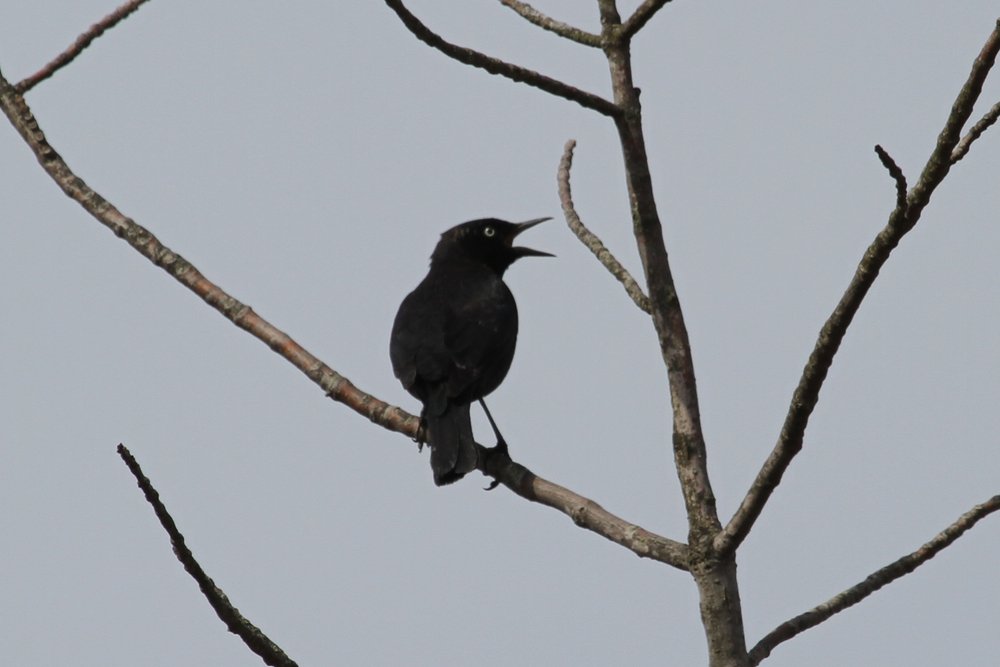
Yesterday I celebrated the first day of the Rusty Blackbird Blitz by walking out into the snowy Tivoli Bays to look for a Rusty. I knew full well I would not see one in the still frozen landscape of the bays. Even the Red-winged Blackbirds have not yet returned. Still, I had to go out on snowshoes to roll out the carpet for the Rusty should it decide to stop over later in the spring.

The first time I saw a Rusty Blackbird was three years ago on the muddy causeway of Cruger Island Road. It was the second spring of my bird-obsessed life, when every bird felt a miracle. My friend Peter introduced us: “Look now,” he said, “this is a bird that will be extinct in our lifetime.” What I saw was an ordinary enough bird, black overall, with a bit of brown rust at the nape, and then eyes, white as if they were bottomless. The bird had a grating song, like a squeaky hinge. At that time I doubted Peter’s pronouncement—it felt too full of doom—but research proved he might be right: Rusty populations have plummeted in the past century, with an 88% population reduction. Though scientists estimate that somewhere between 158,00 and 2 million remain, this once abundant bird is in a population free-fall.
158,000 to 2 million? Let’s put this into numbers people pay most attention to: who wants 2 million dollars? $158,000? But that’s as accurate as it gets because we know little about this bird. Part of it is that the Rusty breeds in inaccessible areas: boreal bogs. Tagging and re-finding those tagged birds has proven near impossible.
A 2010 article in The Condor is titled Rusty Blackbird: Mysteries of a Species in Decline. I can like a science article that admits to the mystery. Is it not all a mystery? That the birds are here at all? That I am here to watch them? that the planet continues to spin?
But the mystery that these scientists are mulling over is why the decline. There is no one simple answer. There’s habitat destruction—that’s almost a given with any dramatic species decline. The woods the Rusty needs on their wintering grounds in the southeastern United States have been transformed into agricultural land. The boreal wetlands where they breed have been lost to peat production, timber harvests, oil and gas exploration—the list is the usual nauseating one that makes me blur over. And then there’s mercury, which the Rusty encounters on both its breeding and wintering grounds. In acidic wetlands, mercury converts to its toxic form, methylmercury. This would likely kill the embryos of the Rusty.
Yet as important as understanding the bird’s breeding and wintering grounds is information on migration. Where do these birds rest up, gather fuel? This is what the Blitz, now in its second year, is about: scientists and conservationists want to understand the challenges this bird faces during migration. So during the next two months they want birders to focus on the Rusty by logging their sightings into eBird.
On my walk, it was quiet except for the crunch of snowshoes and the stop and start conversation with my friend Kate, who is game for any outing that involves snowshoes and birds. As we walked out Cruger Island, I pretended I really could see a Rusty even though there was not a bird in sight. And that possibility, this effort at tracking such an unassuming bird, made me insanely happy. So often it seems that the birds we want to save are the charismatic ones, the ones that are half myth, like the Whooping Crane. Don’t get me wrong, I love that the Whooper is being protected, but I worry that the less exciting birds are left behind. This Blitz gives me hope that we care for all of the birds. Thousands of birders will be out, logging the Rusty’s faint pathway north. Yesterday I did not add to the data, except to say that I tried.

As we left the causeway, a fluttering in some trees caught my attention. I turned my binoculars to see small birds bobbing from the end of branches, working dried seeds pods that looked like flat tin pennies. I tromped past the brush that lines the causeway and walked closer so I could see the little red caps, the white wing bars. Common Redpolls. I watched the birds gather an afternoon meal, wondering what their story might be, then continued on my way home.
Whoop!
In January of 2007, my father and I drove west from Pennsylvania to Arizona together, stopping in Kentucky, Louisiana, Texas. He ate oysters, while I took walks, and together we marveled over our vast country by reading aloud billboards, commenting on the mesquite, the ugliness of strip malls, the trash by the side of the road. The one place he wanted to stop was Aransas National Wildlife Refuge on the upper Texas Coast. Why? To see Whooping Cranes on the bird’s wintering grounds. My father was a novelist, a bookish man, not a naturalist. But the Cranes captured his imagination and he wanted to see them. Aransas, established in 1937 to protect migrating birds and especially the Whooping Crane, is a reliable place to see the birds in winter.
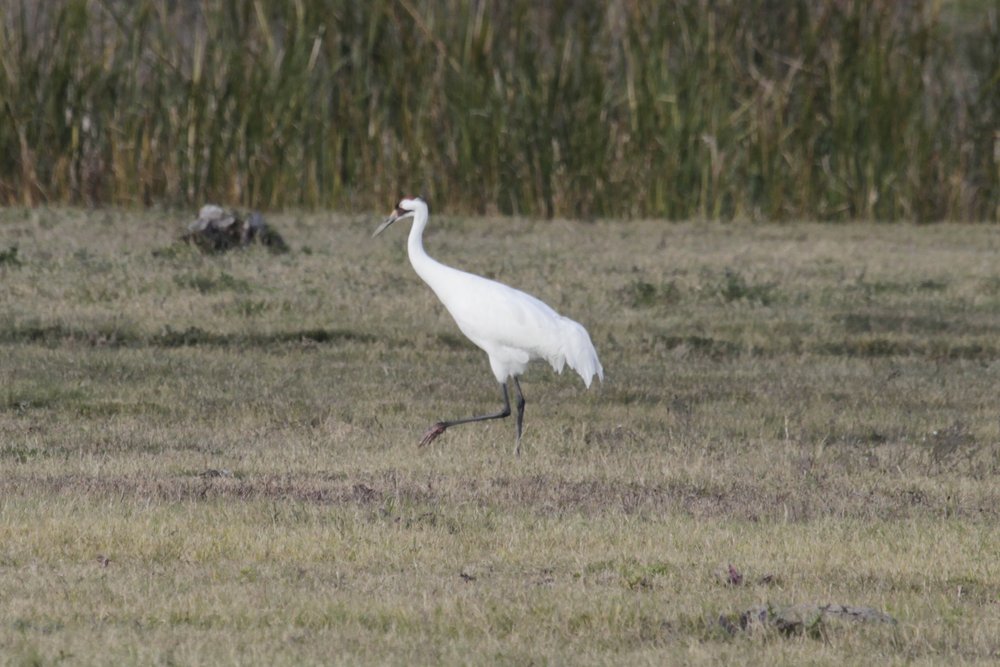
In January of 2007, my father and I drove west from Pennsylvania to Arizona together, stopping in Kentucky, Louisiana, Texas. He ate oysters, while I took walks, and together we marveled over our vast country by reading aloud billboards, commenting on the mesquite, the ugliness of strip malls, the trash by the side of the road. The one place he wanted to stop was Aransas National Wildlife Refuge on the upper Texas Coast. Why? To see Whooping Cranes on the bird’s wintering grounds. My father was a novelist, a bookish man, not a naturalist. But the Cranes captured his imagination and he wanted to see them. Aransas, established in 1937 to protect migrating birds and especially the Whooping Crane, is a reliable place to see the birds in winter.
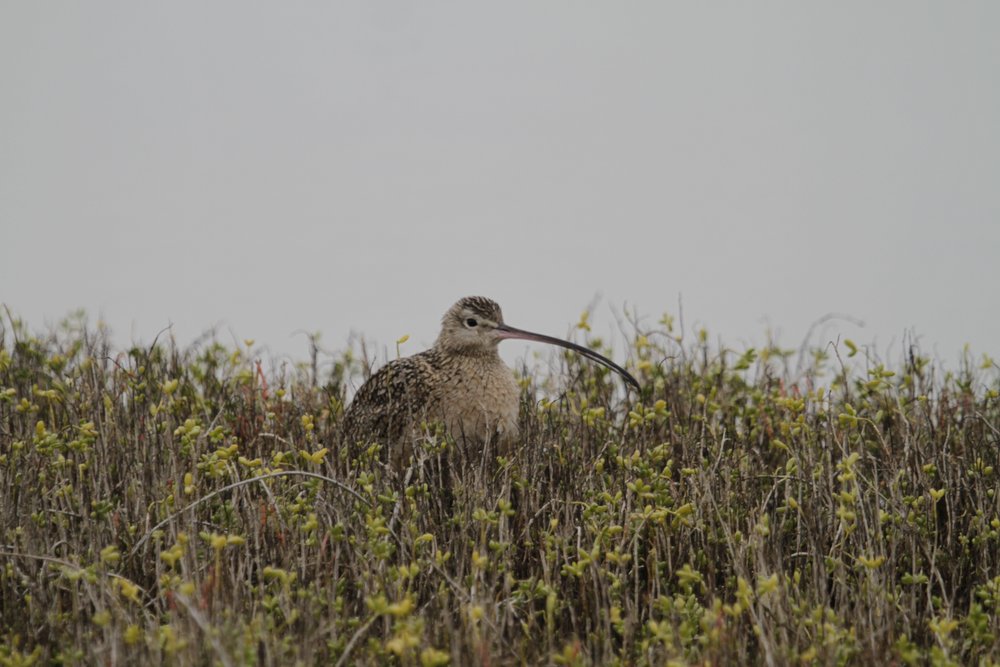
So we stopped in Aransas. And we walked one trail, giddy over the alligators that lazed so close to the trail and marveled over the Roseate Spoonbills. We drove a beautiful 15 mile loop through grasslands and there I saw something take off, something large and white, like a sheet moving through the air. I knew little about birds at the time so I called it a Whooper, but I knew I was lying. Could easily have been a Pelican or a Great Egret. I needed to go back to see those elegant white birds.
This trip of 2015 started in San Antonia in rain, in gray, and well, it pretty much stayed that way through the week. Texas was supposed to be warmer than New York in January and it was—but just barely. My friend Teri and I started by driving the loop at Anahuac, which was like a bird safari, the Coots on every bit of open water, but also Reddish Egrets, White Ibis, and every species of duck that I know. A few days later we were further along the coast. We had passed some of the prettiest and some of the ugliest landscapes we had ever seen. Don’t mess with Texas? The beaches were loaded with garbage. And the views from our rental car roller-coasted from protected refuges to blazing, otherworldly oil refineries.
Just before Aransas we decided to drive south along a sand-dirt road near Collegeville. The land there was extraordinary, salt marshes with grasses in shades of red, orange and yellow. We were alone on that isolated road, seeing Crested Caracara, those dignified looking raptors with flat heads and orange face masks perched on fence posts, and Long-billed Curlews shy in the grasses. And then I heard them: Sandhill Cranes. It’s a call you never forget. I pulled over and we looked at the gray long-legged birds through the scope as they moved in a flock through the grasses.
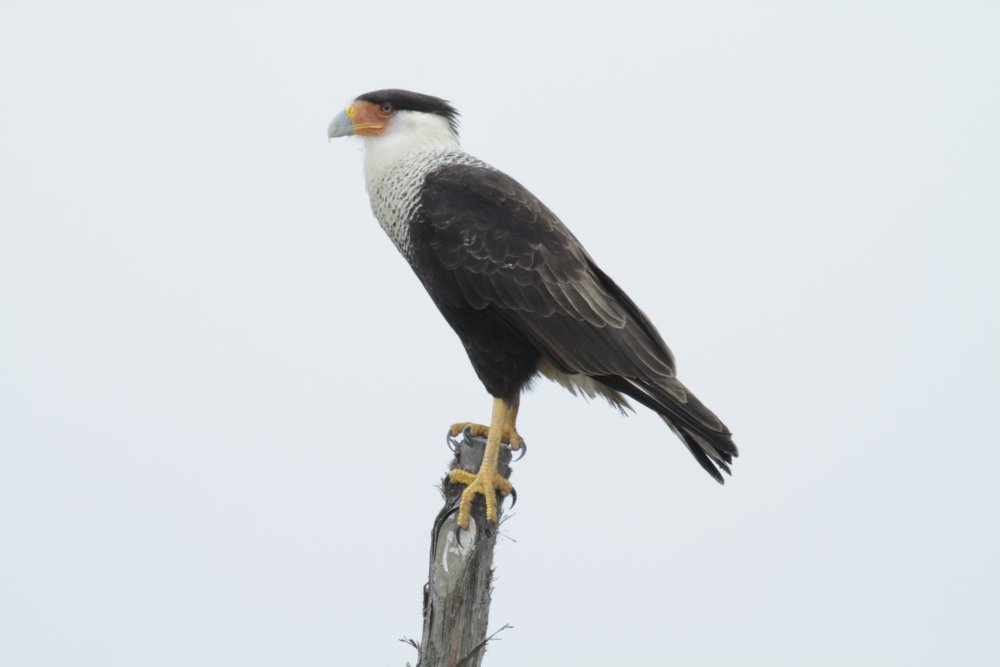
We continued down the road, both of us pointing left, then right at one bird after the next, a bit dizzy from it all. “Egret,” Teri said pointing left. They were the standard long-necked white bird of the trip. “Wait,” I said, noting the birds were bigger, holding themselves not Egret-like. I stopped, pulled out the scope, saw the dark heads of the Whooper and started to tear up.
The Whooping Crane is one of the rarest birds in the United States. In the 1940s populations dropped to 15. From that tenuous number we have climbed to around 600, some in captivity. The return of the Whooper is one of the celebrated acts of conservation: if we put our money, time, and imagination to the task we can do this. The most imaginative part of this is raising chicks using Crane puppets and then teaching the birds to migrate using an ultra light craft.
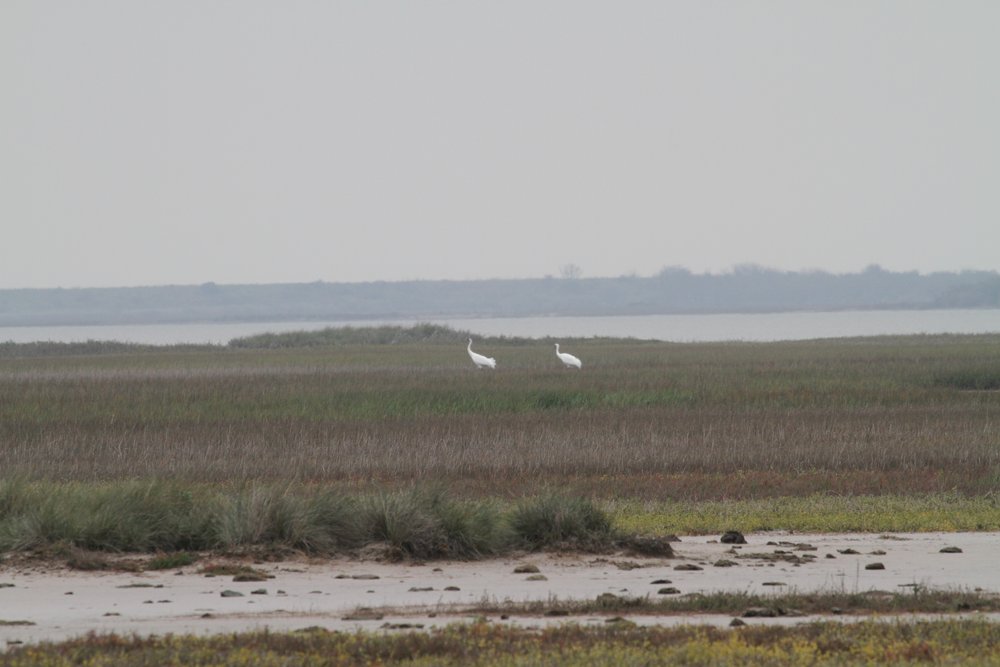
If only we gave all bird species that are endangered this kind of attention, this much love (and money and dedicated researchers). But rather than lamenting that, I stood there on that lonely dirt road grateful we have done this one extraordinary act of protection. The big white birds in the distance grazed about, unaware of my awed excitement. Because they were such a surprise sighting, they felt like my birds. And this, I realize is one of the great joys of birding: finding the unexpected. Or rather in this case, finding the expected in an unexpected place. That it was such a special bird added to the thrill. This all combined to give me a keen sense of discovery, such a rare experience in a world so fully discovered.


